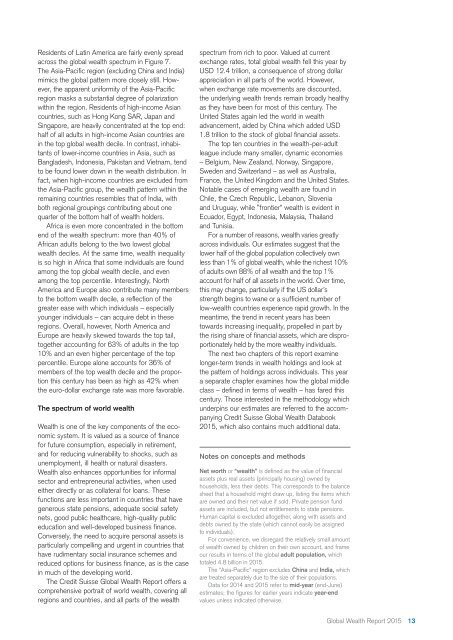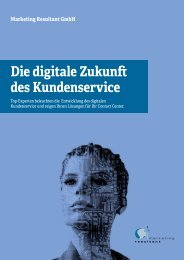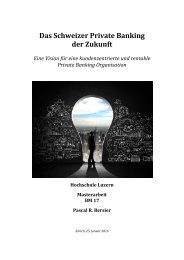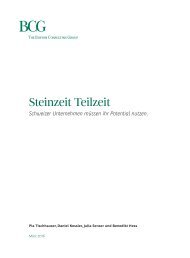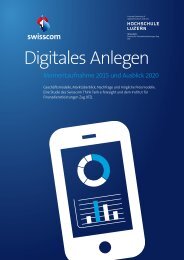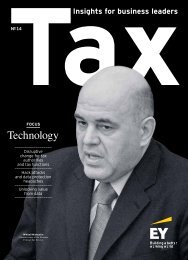Research Institute
ekthsi_0
ekthsi_0
Create successful ePaper yourself
Turn your PDF publications into a flip-book with our unique Google optimized e-Paper software.
Residents of Latin America are fairly evenly spread<br />
across the global wealth spectrum in Figure 7.<br />
The Asia-Pacific region (excluding China and India)<br />
mimics the global pattern more closely still. However,<br />
the apparent uniformity of the Asia-Pacific<br />
region masks a substantial degree of polarization<br />
within the region. Residents of high-income Asian<br />
countries, such as Hong Kong SAR, Japan and<br />
Singapore, are heavily concentrated at the top end:<br />
half of all adults in high-income Asian countries are<br />
in the top global wealth decile. In contrast, inhabitants<br />
of lower-income countries in Asia, such as<br />
Bangladesh, Indonesia, Pakistan and Vietnam, tend<br />
to be found lower down in the wealth distribution. In<br />
fact, when high-income countries are excluded from<br />
the Asia-Pacific group, the wealth pattern within the<br />
remaining countries resembles that of India, with<br />
both regional groupings contributing about one<br />
quarter of the bottom half of wealth holders.<br />
Africa is even more concentrated in the bottom<br />
end of the wealth spectrum: more than 40% of<br />
African adults belong to the two lowest global<br />
wealth deciles. At the same time, wealth inequality<br />
is so high in Africa that some individuals are found<br />
among the top global wealth decile, and even<br />
among the top percentile. Interestingly, North<br />
America and Europe also contribute many members<br />
to the bottom wealth decile, a reflection of the<br />
greater ease with which individuals – especially<br />
younger individuals – can acquire debt in these<br />
regions. Overall, however, North America and<br />
Europe are heavily skewed towards the top tail,<br />
together accounting for 63% of adults in the top<br />
10% and an even higher percentage of the top<br />
percentile. Europe alone accounts for 36% of<br />
members of the top wealth decile and the proportion<br />
this century has been as high as 42% when<br />
the euro-dollar exchange rate was more favorable.<br />
The spectrum of world wealth<br />
Wealth is one of the key components of the economic<br />
system. It is valued as a source of finance<br />
for future consumption, especially in retirement,<br />
and for reducing vulnerability to shocks, such as<br />
unemployment, ill health or natural disasters.<br />
Wealth also enhances opportunities for informal<br />
sector and entrepreneurial activities, when used<br />
either directly or as collateral for loans. These<br />
functions are less important in countries that have<br />
generous state pensions, adequate social safety<br />
nets, good public healthcare, high-quality public<br />
education and well-developed business finance.<br />
Conversely, the need to acquire personal assets is<br />
particularly compelling and urgent in countries that<br />
have rudimentary social insurance schemes and<br />
reduced options for business finance, as is the case<br />
in much of the developing world.<br />
The Credit Suisse Global Wealth Report offers a<br />
comprehensive portrait of world wealth, covering all<br />
regions and countries, and all parts of the wealth<br />
spectrum from rich to poor. Valued at current<br />
exchange rates, total global wealth fell this year by<br />
USD 12.4 trillion, a consequence of strong dollar<br />
appreciation in all parts of the world. However,<br />
when exchange rate movements are discounted,<br />
the underlying wealth trends remain broadly healthy<br />
as they have been for most of this century. The<br />
United States again led the world in wealth<br />
advancement, aided by China which added USD<br />
1.8 trillion to the stock of global financial assets.<br />
The top ten countries in the wealth-per-adult<br />
league include many smaller, dynamic economies<br />
– Belgium, New Zealand, Norway, Singapore,<br />
Sweden and Switzerland – as well as Australia,<br />
France, the United Kingdom and the United States.<br />
Notable cases of emerging wealth are found in<br />
Chile, the Czech Republic, Lebanon, Slovenia<br />
and Uruguay, while ‟frontier” wealth is evident in<br />
Ecuador, Egypt, Indonesia, Malaysia, Thailand<br />
and Tunisia.<br />
For a number of reasons, wealth varies greatly<br />
across individuals. Our estimates suggest that the<br />
lower half of the global population collectively own<br />
less than 1% of global wealth, while the richest 10%<br />
of adults own 88% of all wealth and the top 1%<br />
account for half of all assets in the world. Over time,<br />
this may change, particularly if the US dollar’s<br />
strength begins to wane or a sufficient number of<br />
low-wealth countries experience rapid growth. In the<br />
meantime, the trend in recent years has been<br />
towards increasing inequality, propelled in part by<br />
the rising share of financial assets, which are disproportionately<br />
held by the more wealthy individuals.<br />
The next two chapters of this report examine<br />
longer-term trends in wealth holdings and look at<br />
the pattern of holdings across individuals. This year<br />
a separate chapter examines how the global middle<br />
class – defined in terms of wealth – has fared this<br />
century. Those interested in the methodology which<br />
underpins our estimates are referred to the accompanying<br />
Credit Suisse Global Wealth Databook<br />
2015, which also contains much additional data.<br />
Notes on concepts and methods<br />
Net worth or “wealth” is defined as the value of financial<br />
assets plus real assets (principally housing) owned by<br />
households, less their debts. This corresponds to the balance<br />
sheet that a household might draw up, listing the items which<br />
are owned and their net value if sold. Private pension fund<br />
assets are included, but not entitlements to state pensions.<br />
Human capital is excluded altogether, along with assets and<br />
debts owned by the state (which cannot easily be assigned<br />
to individuals).<br />
For convenience, we disregard the relatively small amount<br />
of wealth owned by children on their own account, and frame<br />
our results in terms of the global adult population, which<br />
totaled 4.8 billion in 2015.<br />
The “Asia-Pacific” region excludes China and India, which<br />
are treated separately due to the size of their populations.<br />
Data for 2014 and 2015 refer to mid-year (end-June)<br />
estimates; the figures for earlier years indicate year-end<br />
values unless indicated otherwise.<br />
Global Wealth Report 2015<br />
13


